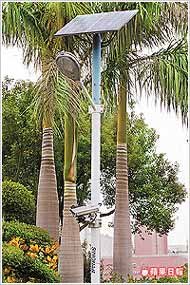 Solar panels sample applications Solar panels sample applications |
Solar energy can light up a lamppost.

|
Solar panels can be placed on a roof.

|
Or you can create a big plant, like the one in Portugal.

|
|
|
 |
 SUN AND SAND. An introduction to solar panels SUN AND SAND. An introduction to solar panels |
 Solar radiation reaches the Earth’s upper atmosphere at a rate of 1,366 watts per square metre W/m2). When solar radiation travels through the atmosphere, 6% of it is reflected and 16% is absorbed, resulting in a peak irradiance at the equator of 1.020 (W/m2). Average atmospheric conditions (clouds, dust, pollutants) further reduce insulation by 20% through reflection and 3% through absorption.
Solar radiation reaches the Earth’s upper atmosphere at a rate of 1,366 watts per square metre W/m2). When solar radiation travels through the atmosphere, 6% of it is reflected and 16% is absorbed, resulting in a peak irradiance at the equator of 1.020 (W/m2). Average atmospheric conditions (clouds, dust, pollutants) further reduce insulation by 20% through reflection and 3% through absorption.
This massive quantity of free energy can be used. Photovoltaic is a technology in which light is converted into electrical power by using solar cells. Solar cells are made of silicon, which is the second most abundant element in nature after oxygen. But even though sunshine is free of charge and silicon is abundant, the cost of each KW/h that you can produce with solar irradiation is high. Producing energy with oil or gas is still cheaper. As a result, governments don’t include photovoltaic technology in their energy production policy. Economy has always been the only relevant topic for policy.
The good news is that the Kyoto treaty has changed many governments´ views on energy production policies, so there is hope.
Oil production is, or nearly is at its peak and the production of gas will be at its peak in 20-30 years time. The world’s energy requirements increase by 15% a year, and pollution is drastically changing the environment, with catastrophic scenarios forecast for the future. The production of clean energy has therefore become essential. Large-scale incentive programmes offering financial incentives such as "feed-in tariffs" are greatly accelerating solar photovoltaic installations in many countries.
Photovoltaic is the only clean alternative for people who think about the environment that they live in.
But Photovoltaic is not only that.
Feed-in tariffs also give the opportunity to reclaim up to 20% per year of the investment needed to install the power plant, which gives you free energy for at least 25 years.
So let’s all live in a cleaner and richer world!
|
 What is a solar panel What is a solar panel |
 The basic and most important component of a Photovoltaic panel is silicon. The basic and most important component of a Photovoltaic panel is silicon.
Silicon (Si) is the second most common element on Earth after oxygen, and is extracted from common sand. Silicon has many industrial uses. Elemental silicon is the principal component of most semiconductor devices, most importantly integrated circuits or microchips. Silicon is widely used in semiconductors because it remains a semiconductor at higher temperatures.
But to be used, silicon has to be pure, and the process to make it is very expensive.
Once silicon is transformed into an ingot of pure silicon, it will be cut into wafers and then transformed into Solar cells. Once transformed into an ingot of pure silicon, it is cut into wafers and then transformed into solar cells. The solar cells are then applied in a panel and put together in a series. Once installed, the solar panel absorbs the photons that are in sunlight and transforms them into direct current. Direct current then goes into an inverter that transforms it into alternate current, providing electricity for everyday use.
There are different types of solar panels. The most common panels are monocrystalline and polycrystalline, but increasingly the industry is developing thin film solar panels.
Thin film has to be developed using new semiconductor materials, including amorphous silicon, copper indium diselenide, cadmium telluride and film crystalline silicon. At present thin film is less efficient than common mono or polycrystalline solar panels. In fact, to obtain the same Kw/p installed, you need to have more space to install a thin film power plant than a mono-polycrystalline power plant. But thin film has one distinctive advantage. It can be easly installed on any surface because it is very “thin” and flexible. So applications on rounded roofs, for example, will be much easier than with common panels.
For European markets, specific certifications are required for Photovoltaic panels. The most important is IEC 61215, which certifies that the panels satisfy all kind of tests(please find specifications in "certifications" section), assuring the customer of good quality panels.
|
|
|